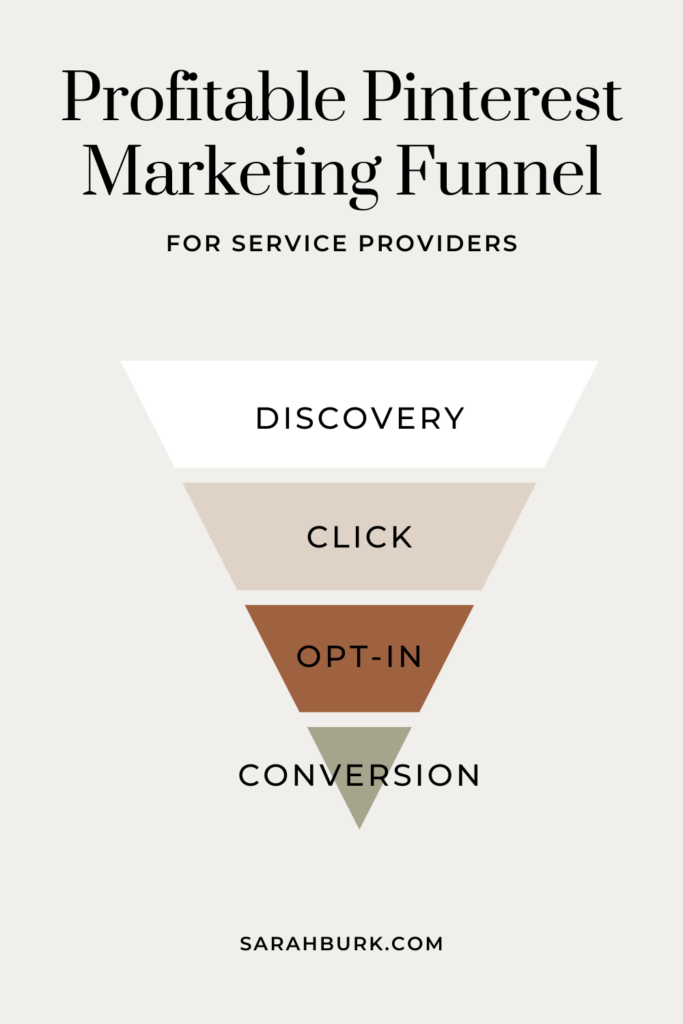Do you feel like you’ve been doing everything right on Pinterest but not getting the results to show it?
Or maybe you’ve been driving leads and building an audience on Instagram for a while and aren’t sure how to add Pinterest to the equation.
If so, this post is for you.
Because between you and me, successful Pinterest marketing actually takes a lot more than just posting on Pinterest and calling it a day, especially for service-based business owners.
While bloggers can monetize their Pinterest traffic based on ad revenue and affiliate sales, and product-based businesses can offer a lower-ticket, no-brainer product, marketing high-ticket services on Pinterest takes a different skillset and strategy.
To effectively market your service-based business on Pinterest, you need to take a look at the entire marketing funnel, both on and off Pinterest.
We’ll cover who your Pinterest audience is, how to create content that meets them where they’re at, and how to nurture them through your Pinterest funnel until they become a client.
Pinterest Marketing Funnels for Service-Based Businesses
But first…
What is Your Pinterest Funnel?
A marketing funnel is a representation of a consumer’s journey from discovery to conversion. Understanding the journey from the first time a user discovers your content on Pinterest to the moment they “convert” is essential so you know how to optimize each step along that funnel.
In your overall marketing strategy, Pinterest is a “top-of-funnel” platform. You’re using Pinterest to reach new audiences, generate brand awareness, and start turning users into leads.
So who are those users? And how are they different from your audience on other platforms?
Who is Your Pinterest Audience?
In general, Pinterest users visit Pinterest to actively look for something. Whether that’s inspiration, information, or solutions, they’re searching with a purpose.
What that means for service providers marketing on Pinterest is that you need to lead with value. Pinterest cannot be a sales-content-only platform.
This is especially true because for most users discovering your content on Pinterest, it’s the first time they’re interacting with your brand. And they don’t care about you — yet.
Your Pinterest audience is generally ice-cold. They don’t know who you are, so they need to be nurtured and warmed up before they’ll be ready to convert.
This is a big difference from your Instagram audience, who is more familiar with you, is using the platform to connect, and cares a little bit more beyond what you can provide for them.
On the other hand, Pinterest users’ active intent on the platform makes them really valuable leads, because they’re more likely to take action if your content or product solves the problem they’re dealing with at the moment.
And because you’re capturing these people’s attention in an early stage of awareness, you’re building brand trust and loyalty a lot earlier than most of your competitors on Instagram.
How to Create Strategic Content for Your Pinterest
If you’re not directly selling your services, what content should you create?
Great question, glad you asked.
Pinterest users are typically at a “try to DIY” stage. They’re looking for specific how-to content to support them as they build their business.
So don’t discourage them by throwing them a bunch of content about how the only way to succeed is by hiring you as their copywriter, OBM, designer, whatever.
We’re trying to build brand trust and turn your audience into super fans, plus actually get people clicking over to your website.
To create content that your audience will actually want to read and that will start to nurture your ideal clients through your Pinterest funnel, you have to get in their heads.
Use these 5 questions the next time you sit down to write a blog post, create a lead magnet, or film a Reel, because that’s the content your Pinterest audience is going to eat up!
- What is their biggest challenge at the moment?
- How can you give them an easy win?
- What do they know about your industry?
- What are they already searching for on Pinterest?
- What concerns would they have about outsourcing?
Oh, and I think it goes without saying, but it’s crucial that you have at least a general understanding of who your ideal client is.
Promoting Your Content on Pinterest
Once you’ve created the content, you need people to discover that content on Pinterest and actually click through to your website. To do that, make sure you’re following these guidelines:
- Create and optimize a Pinterest Business account
- Use Pinterest keywords in your pin titles and descriptions
- Include calls to action in your pin graphics and pin descriptions
- Consistently post new pins for your content
How to Optimize Your Blog Posts
Congrats! You’ve accomplished your goal of creating Pinterest content worthy of a click and now your ideal client is reading your blog post.
Like, right now.
Quick, what do you do?!
Before you let that client ‘x’ out and slip away into the world wide web, it’s time to actually capture that lead.
Hint: this is where an email list comes in.
You’ll want to drop opportunities for your blog reader to sign up for your list all over your website, where relevant. Whether that’s a simple “subscribe” form or a high-value, free lead magnet, make sure your audience knows exactly how they can get tons more info and tips from you.
Within the body of your blog post, make sure to link to more of your blogs, so they can keep going down the rabbit hole of incredible content you’ve created.
And if you’re lucky enough to get a reader who scrolls all the way to the end, don’t forget a call to action. Here are a few to choose from:
- Ready to stop worrying about it completely? Here’s how I can help: [promote your services]
- Want more tips like these in your inbox every week? Subscribe to my newsletter!
- There’s more where this came from on Instagram. Come join the party!
How to Nurture Your New Email Subscribers
Say it with me — don’t ghost your email subscribers!!!
It’s no small feat to give up a piece of personal information like an email address, so don’t leave your new subscriber hanging out in the digital void. Because otherwise, what’s the point of having them sign up in the first place?
I know, we’ve all got a million things to do, but if the only interaction you have with your email subscriber is a “Thanks for subscribing” or “Here’s your freebie” email, they’re going to forget about you sooner than Target puts up Valentine’s decorations after Christmas.
The best and easiest way to make the most of that new email subscriber is by setting up a welcome sequence to kick off anytime someone joins your list or downloads a freebie.
Here’s an example of a simple welcome sequence you can try:
- Thank You/Freebie Delivery
- Introduction to You/Your Brand
- Additional Value (extra freebie, popular blog posts, etc.)
- How They Can Work With You
- What to Expect/Chat Later
Wanna see a welcome sequence in action? You can sign up for my list and get your free Pinterest checklist (and of course an inside look at my own welcome sequence).
I use Flodesk for all of my email marketing and it makes setting up sequences like this so simple. You can get 50% off your first year of Flodesk if you use the code SARAHB!
After your welcome sequence, it’s important to keep nurturing your list. Whatever frequency you said you’d get in touch, keep up with it. Weekly is best so your subscribers don’t forget who you are, but pick something you can commit to and stick to it.
With time and consistency, your email subscribers will get to know and trust you as a person and as a service provider.
Don’t forget to keep providing value and also remind your subscribers about your offers from time to time. Those once-cold leads from Pinterest are moving through your Pinterest funnel and getting piping hot, baby!
The Service Provider’s Profitable Pinterest Marketing Funnel
If you’ve made it this far, you’ve actually already created your Pinterest marketing funnel! We’ve covered all the steps along the ideal funnel for service providers to make money using Pinterest.
But because I love you, let’s break it down again, step-by-step.
The model we’re using for this Pinterest funnel is adapted from one of the most common models of marketing funnels: AIDA (awareness, interest, desire, action).

For your profitable Pinterest marketing funnel, your ideal clients will go from discovery to click to opt-in to conversion.
- Discovery — This is where your potential client first finds you; it’s the first Pinterest search that gets your content in front of them. Understanding your ideal audience and on-Pinterest strategy is what will help you show up in your clients’ feeds and capture their attention.
- Click — You’ve convinced your potential client to leave Pinterest and land on your website, where they read your content and consider your offerings. Optimizing your blog posts will help you make the most of this new traffic.
- Opt-In — Whether your potential client downloaded a freebie, requested your service guide, or just wants to join the email list to stay in touch, this is a strong signal of “desire,” or interest in your brand. Now it’s time for your high-touch welcome sequence to take over and nurture!
- Conversion — You’ve moved the user through your Pinterest funnel, providing valuable content, nurturing them through your email list, and educating them about your offers so when the time comes to invest, you’re top of mind and they’re ready to checkout!
Your Pinterest funnel is a long-term, multi-faceted situation
There are multiple factors that determine whether a Pinterest user ultimately turns into a lead or a client. But by optimizing every touchpoint along your Pinterest funnel, you’re giving yourself the best chance for success.
It’s worth mentioning, too, that a client booking isn’t the only form of conversion. For some, getting people onto an email list is conversion enough. Or maybe your primary goal is to sell more templates or courses.
This model of a Pinterest marketing funnel is just that — a model. Your service-based business is individual and unique, which means you need more than just a cookie-cutter strategy.
If you want to dive further into your Pinterest funnel, you can grab your Pinterest funnel audit guide here. Or if you’d rather someone else do it for you (ahem, me), reach out today!
